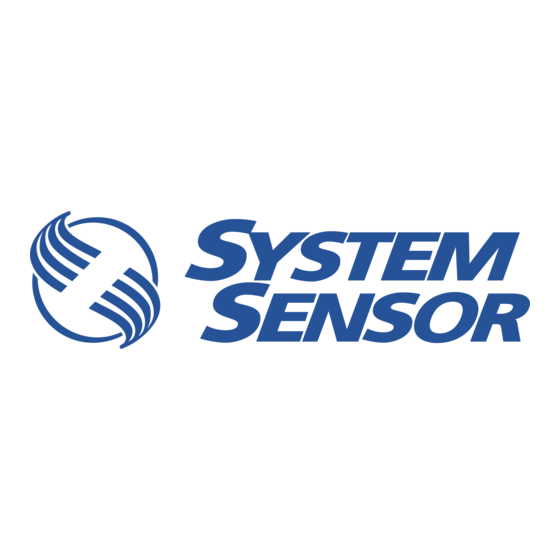Table of Contents
Advertisement
Quick Links
Installation AND MAINTENANCE INSTRUCTIONS
2100AT Photoelectronic
Smoke Detector with Fixed Heat
and Integral Temp-3 Sounder
Figure 1. Wiring diagram for the 2100AT detector:
Polarity must be observed on the power and remote annunciator connections.
Specifications
Diameter:
Height (including mounting bracket):
Weight:
Operating Temperature Range
Operating Humidity Range:
Latching Alarm:
Audible Signal:
Heat Sensor:
Electrical Ratings
System Voltage (nominal):
Minimum:
Maximum:
Maximum Ripple Voltage:
Standby Current:
Alarm Ratings:
Reset Voltage:
Reset Time:
Start-up Time:
EOL Relay:
Special Considerations:
D200-69-00
IMPORTANT: OBSERVE POLARITY
+
INITIATING
LOOP
–
+
–
UL LISTED
COMPATIBLE
CONTROL
RA400Z
PANEL
REMOTE
ANNUNCIATOR
OPTIONAL CLASS A WIRING
NOTE: Only one detector per zone shall be used, unless when in alarm the panel switches
the zone to a reverse polarity, noncurrent-limited power supply. The 2100AT
detector shall not be mixed with other 2-wire detector types on the same zone.
5.5 inches (140 mm)
2.05 inches (52 mm)
7.5 oz. (210 g)
32° to 100° F (0° to 38° C)
10% to 93% Relative Humidity, Noncondensing
Reset by momentary power interruption
85 dBA minimum when in alarm or with supply polarity reversed
135° F Fixed Temperature Electronic Thermistor
12 or 24 VDC
8.5 VDC
35 VDC
30% of nom. Voltage (peak to peak)
50 µ A average, 100 µ A maximum
29 mA typical at 12 VDC, 63 mA typical at 24 VDC, 100 mA maximum
(If used, the RA400Z Remote Annunciator operates within the specified detector
alarm currents.)
1.8 VDC minimum
0.6 seconds maximum
30 seconds maximum (after 60 sec. reset)
A77-716B, 12/24 VDC
NOTE: Only one detector per zone shall be used, unless when in alarm the panel
switches the zone to a reverse polarity, non-current limited power supply. For
panels that do not provide this feature, a reversing relay, such as System Sensor's
RR-2, may be used. When utilized with the 2100AT, it allows for more than one de-
tector to be utilized on a loop. Some panels may require the use of programmable
outputs. Refer to System Sensor literature for further information on the RR-2.
The 2100AT detector shall not be mixed with other 2-wire detectors on the same
zone.
–Due to the built-in temporal pattern, use this detector only with a non-coded
power source.
EOL
+
P
W
+
R
–
+
A
-
A
NOT
USED
1
3825 Ohio Avenue, St. Charles, Illinois 60174
1-800-SENSOR2, FAX: 630-377-6495
A78-2336-15
I56-1145-05R
Advertisement
Table of Contents

Subscribe to Our Youtube Channel
Summary of Contents for System Sensor 2100AT
- Page 1 System Sensor’s RR-2, may be used. When utilized with the 2100AT, it allows for more than one de- tector to be utilized on a loop. Some panels may require the use of programmable outputs.
- Page 2 RA400Z Remote Annunciator. Mounting A78-2563-03 Each 2100AT detector is supplied with a mounting bracket that permits the detector to be mounted: 1. To a single gang box, or 2. Directly to a 3-1/2 inch or 4 inch octagonal box, or 3.
- Page 3 System Sensor smoke detectors are marked with a compat- ible identifier located as the last digit of a five digit code stamped on the back of the product. Connect detectors only to compatible control units as indicated in System Sensor’s compatibility chart which contains a current list of UL- listed compatible control units and detectors.
- Page 4 Please refer to insert for the Limitations of Fire Alarm Systems System Sensor warrants its enclosed smoke detector to be free from de- fects in materials and workmanship under normal use and service for a period of three years from date of manufacture. System Sensor makes no other express warranty for this smoke detector.











Need help?
Do you have a question about the 2100AT and is the answer not in the manual?
Questions and answers